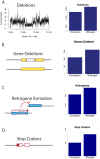Excess of genomic defects in a woolly mammoth on Wrangel island
- PMID: 28253255
- PMCID: PMC5333797
- DOI: 10.1371/journal.pgen.1006601
Excess of genomic defects in a woolly mammoth on Wrangel island
Abstract
Woolly mammoths (Mammuthus primigenius) populated Siberia, Beringia, and North America during the Pleistocene and early Holocene. Recent breakthroughs in ancient DNA sequencing have allowed for complete genome sequencing for two specimens of woolly mammoths (Palkopoulou et al. 2015). One mammoth specimen is from a mainland population 45,000 years ago when mammoths were plentiful. The second, a 4300 yr old specimen, is derived from an isolated population on Wrangel island where mammoths subsisted with small effective population size more than 43-fold lower than previous populations. These extreme differences in effective population size offer a rare opportunity to test nearly neutral models of genome architecture evolution within a single species. Using these previously published mammoth sequences, we identify deletions, retrogenes, and non-functionalizing point mutations. In the Wrangel island mammoth, we identify a greater number of deletions, a larger proportion of deletions affecting gene sequences, a greater number of candidate retrogenes, and an increased number of premature stop codons. This accumulation of detrimental mutations is consistent with genomic meltdown in response to low effective population sizes in the dwindling mammoth population on Wrangel island. In addition, we observe high rates of loss of olfactory receptors and urinary proteins, either because these loci are non-essential or because they were favored by divergent selective pressures in island environments. Finally, at the locus of FOXQ1 we observe two independent loss-of-function mutations, which would confer a satin coat phenotype in this island woolly mammoth.
Conflict of interest statement
The authors have declared that no competing interests exist.
Figures


Similar articles
-
The flickering genes of the last mammoths.Mol Ecol. 2012 Jul;21(14):3379-81. doi: 10.1111/j.1365-294x.2012.05594.x. Mol Ecol. 2012. PMID: 22953331
-
Complete genomes reveal signatures of demographic and genetic declines in the woolly mammoth.Curr Biol. 2015 May 18;25(10):1395-400. doi: 10.1016/j.cub.2015.04.007. Epub 2015 Apr 23. Curr Biol. 2015. PMID: 25913407 Free PMC article.
-
Complete Columbian mammoth mitogenome suggests interbreeding with woolly mammoths.Genome Biol. 2011;12(5):R51. doi: 10.1186/gb-2011-12-5-r51. Epub 2011 May 31. Genome Biol. 2011. PMID: 21627792 Free PMC article.
-
Elephant natural history: a genomic perspective.Annu Rev Anim Biosci. 2015;3:139-67. doi: 10.1146/annurev-animal-022114-110838. Epub 2014 Dec 8. Annu Rev Anim Biosci. 2015. PMID: 25493538 Review.
-
Cloning the mammoth: a complicated task or just a dream?Adv Exp Med Biol. 2014;753:489-502. doi: 10.1007/978-1-4939-0820-2_19. Adv Exp Med Biol. 2014. PMID: 25091921 Review.
Cited by
-
Mitogenome evolution in the last surviving woolly mammoth population reveals neutral and functional consequences of small population size.Evol Lett. 2017 Nov 28;1(6):292-303. doi: 10.1002/evl3.33. eCollection 2017 Dec. Evol Lett. 2017. PMID: 30283657 Free PMC article.
-
Functional Architecture of Deleterious Genetic Variants in the Genome of a Wrangel Island Mammoth.Genome Biol Evol. 2020 Mar 1;12(3):48-58. doi: 10.1093/gbe/evz279. Genome Biol Evol. 2020. PMID: 32031213 Free PMC article.
-
ARIADNA: machine learning method for ancient DNA variant discovery.DNA Res. 2018 Dec 1;25(6):619-627. doi: 10.1093/dnares/dsy029. DNA Res. 2018. PMID: 30215675 Free PMC article.
-
Genomic signatures of bottleneck and founder effects in dingoes.Ecol Evol. 2023 Sep 19;13(9):e10525. doi: 10.1002/ece3.10525. eCollection 2023 Sep. Ecol Evol. 2023. PMID: 37732287 Free PMC article.
-
Genetic Diversity and Thermal Performance in Invasive and Native Populations of African Fig Flies.Mol Biol Evol. 2020 Jul 1;37(7):1893-1906. doi: 10.1093/molbev/msaa050. Mol Biol Evol. 2020. PMID: 32109281 Free PMC article.
References
-
- Vartanyan SL, Arslanov KA, Karhu JA, Possnert G, Sulerzhitsky LD (2008) Collection of radiocarbon dates on the mammoths (mammuthus primigenius) and other genera of wrangel island, northeast siberia, russia. Quaternary Research 70: 51–59. 10.1016/j.yqres.2008.03.005 - DOI
-
- Lynch M (2007) The origins of genome architecture, volume 98 Sinauer Associates; Sunderland.
Publication types
MeSH terms
Substances
Grants and funding
LinkOut - more resources
Full Text Sources
Other Literature Sources
Research Materials

